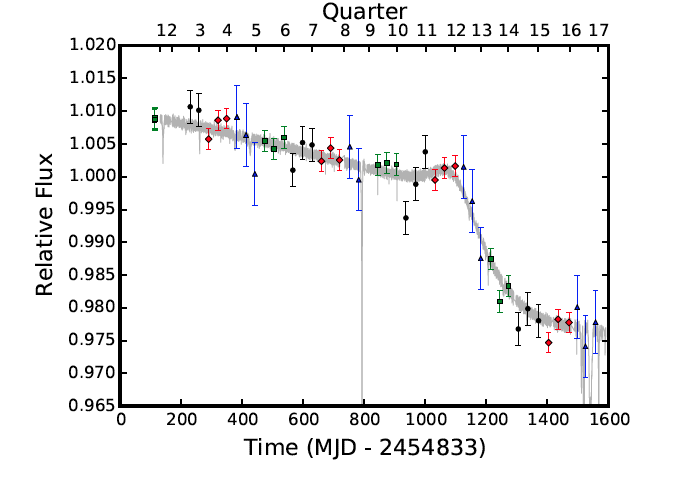In an unpublished paper posted today to arXiv, Caltech astronomer Ben Montet and Joshua Simon of the Carnegie Institute describe the results of a new photometric analysis of Tabby's Star, which was first flagged in the Kepler Space Telescope's database by citizen science astronomers.
By carefully examining all the full-frame images collected during Kepler's observational campaign, Montet and Simon discovered something astonishing: Not only did the star's light output occasionally dip by up to 20 percent, its total stellar flux diminished continuously over the course of four years.
For the first 1000 days of Kepler's campaign, Tabby's Star decreased in luminosity by approximately 0.34 percent per year. For the next 200 days, the star dimmed more rapidly, its total stellar flux dropping by 2 percent before leveling off. Overall, Tabby's Star faded roughly 3 percent during the four years that Kepler stared at it—an absolutely enormous, inexplicable amount. The astronomers looked at 500 other stars in the vicinity, and saw nothing else like it.
"The part that really surprised me was just how rapid and non-linear it was," Montet told Gizmodo. "We spent a long time trying to convince ourselves this wasn't real. We just weren't able to."
This isn't the first time astronomers have claimed that Tabby's Star is fading. Earlier this year, Bradley Schaefer of Louisiana State University decided to examine the star in old photographic plates of sky dating back to the 19th century. He found that over the past 100 years, the star's total light output has diminished by a whopping 19 percent. But shortly after publishing his claims, other astronomers started poking holes in them, saying that the observed dimming was the result of flawed data. Schaefer pushed back, and things got a little bit ugly.

Jason Wright, the Penn State astronomer who first suggested that Tabby's Star might be the site of a vast alien construction project, agreed that the new analysis lends credibility to Schaefer's claim of century-long dimming. "The new paper states, and I agree, that we don't have any really good models for this sort of behavior," he said. "That's exciting!"
Keivan Stassun, an astronomer at Vanderbilt who disputed the idea of long-term dimming, said that Tabby's star continues to defy explanation. "[Montet's] intriguing new findings suggest that none of the considered phenomena can alone explain the observations," he told Gizmodo. "In the end, figuring out this puzzle may require accounting for a combination of effects."
Some of the most credible explanations to date include a swarm of cometary fragments, the effect of a distorted star, or the remnants of a shattered planet. Certain things can explain long-term dimming while others can explain short-term flickering, but as Montet put it, "nothing nicely explains everything."
What's clear is that we aren't going to solve this mystery until we get a better look at this star, which is exactly what Tabby Boyajian—the astronomer who first discovered it—is gearing up to do.
Following a successful crowdfunding campaign to secure time at the the Las Cumbres Observatory Global Telescope Network, Boyajian is going to observe her namesake star for a full year, with the hope of catching it in the act of flickering. If that happens, other telescopes around the world will be alerted and swiftly mobilized. We'll be able to watch the star wink at us across the entire electromagnetic spectrum, and hopefully, decode its message.




Reader Comments
The Continuity Manager for the linear space-time identity, is fading to the opening of communication with The Infinite in its Own Terms.
That is to say - our structures of meaning that have been imposed as distortion filters upon awareness of Existence - are dis-integrating to open Fresh Perspective.
Get a fresh set of meanings - for the old set have been corrupted, usurped, adulterated and subverted to operate against the Movement of our being - the movement of an integrative embrace that uncovers, recognizes and embody the resonance of the true of what and who we - that Existence is -as can be imagined and experienced.
Self-Aware contains all dimensionality within its own expansion. Perhaps the word 'self' is misleading - because where a 'self' is presumed and asserted to be in some kind of control, the full embrace of arising 'world-experience' is held in check, and time operates a process of covering and discovery in place of Always.
I write here in intuitive prose. It can only be 'read' on the vibration is is sent. The resonance of stirring recognitions is not a science of objective external fixity or continuity - so much as the knowing again of the subtler currents of information and communion that were covered over by the engagement within a rigid and fixed identity in its narrative 'separation' from what might be called the Living Universe.
Alien simply means 'other' or stranger. The recognition of Life, as the Movement of Life through us - expands the Human Definition - and breaks the human conditioning - from the inside out - and not as the force of a strange god or the unknown unlove of a cruel Other - which has conditioned our consciousness to mask our true being with a stranger to which Life is sacrificed so as to have a 'separate' life in which to judge all things in our image rather than recognize the true imag-ination of an Infinite Creator.
The convergence of past and future in Presence is no mere present-ation. But an embrace of what had been denied acceptance.
Aligning with true presence is the willingness within the transformation of the personality to its true function - which is holding a focus within and as an extension of Consciousness.
Confusion of identity with one's avatar seems to split the Mind. Pausing the mind allows the felt recognition of a movement of wholeness of being - in which a clear and direct appreciation serves true foundation for a balance within wholeness - rather than the attempt to coerce Experience/outcome by an act of coercion from an imagined point OUTSIDE of and other to wholeness of self.
When your "Higher Mind" winks at you - feel the stirring on the vibrational wavelength this prompting comes to you, rather than translate into terms of a split minded war of survival on behalf of maintaining the split.
Or believe your insignificance and project that onto a Universe that has no capacity to embrace or integrate or accept You. But it is by your acceptance that your word is given - and the reward or fruit, tasted and shared. Garbage in/garbage out. What we focus in is our desire and intention - whether we consciously recognize our act or not.
I have a sense that We do not accept becoming Infinitely or forever lost to loss, pain and meaningless - and so there are limits - no matter how ingeniously we may seek to redefine our self or our experience to 'outsource' pain onto 'unconscious' onto 'body, onto 'world' and onto the Brotherness of Life Companioning that is thus made Other and stranger - reflecting our fear but regarded instead as a self motivating intent of threat. We give the 'self' we make for ourself to others and then hate them for it - because we hate the limiting and loss of being coercively defined... until of course our split off personality is trained and conformed to sacrifice automatically to the imprint of appeasing and allaying fearful outcome - masked of course in the presentation of 'independence'.
We have 'become' alien or stranger unto ourselves for the sake of a narrative focus in the illusion of power. Why 'illusion' - because there is no-one to receive or share this 'power' excepting victims and slaves to fear. Illusions have all the reality you give to them. This restates your true status in Cause and allows effect to be used as feedback instead of assigning it 'creative independence'.
Perhaps this message was supported by an Ancient Knowing that was before time as we now account it was possible to take seriously. Perhaps by a Future self of compassionate embrace and acceptance of all its past. But I tell no one anything they are not already willing to recognize within their own knowing - and I must speak nonsense for those who want more time to think about 'it' so as to contest the validation of thought they identify in.
What is the point of it all but You? And what are the points of view but points of You? The static linear concept does not allow movement, recognition-expansion and evolution-transformation. Enter the breaking, undermining splitting and controlling 'evil'. Now you are broken enough from a fixed choice to recognize it is choice! Now a willingness to re-evaluate the foundations of your thought system awakens as a fresh sense of simply honest curiosity. Now there is a pathway of NOT squelching it or sacrificing the movement of Life to a conformity of ancient fear conditionings.
If you lean on the world, its changes and you fall. So find an inner balance within your experience of the whole - and enjoy the world for what it is - without losing your feeling of being or Soul awareness.
"It's time, Jim, but not as we know it".